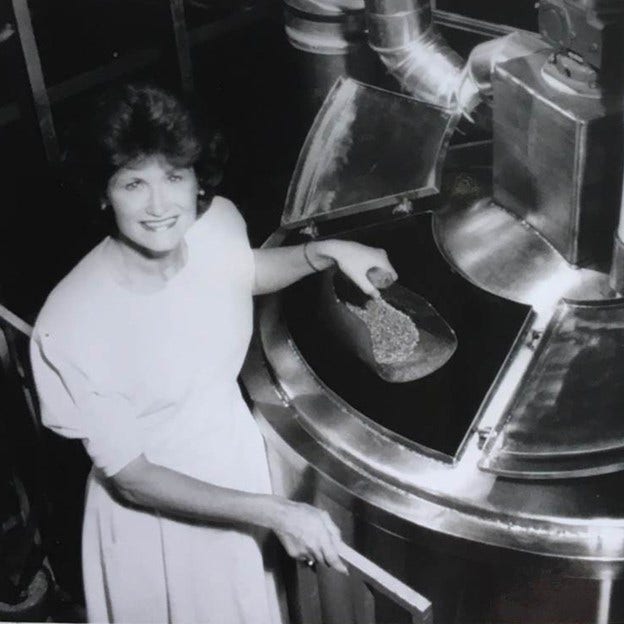The History of Women in Brewing
Welcome to March. This month brings Basketball, St. Patrick’s Day, the first day of Spring, The Ides of March, and of course, Women’s History Month. Now, you may or may not know, but women have played a pivotal role in the evolution of brewing since humans started doing it! In fact, you cannot really have a “scholarly” conversation about the history of beer without mentioning the great “Alewives” of old that contributed so directly to the dynamic evolution of the “craft”. Though Western societies have viewed brewing as a male-dominated field for the last 150 years, traditionally, it was an activity engaged in and governed by women. So, join me on this brief look into the female role in beer production, through the ages!
Starting with the industrial revolution and through most of the 19th Century, the practice of beer production was relegated primarily to men; women were mostly filling rolls as “barmaids” and “publicans” with the occasional few, found in auxiliary roles of production such a packaging. But what about before that? Who likely made the first beer to grace the lips of a human? Well, I bet you can already guess the answer… The world’s first Brewster was indeed a woman. Archaeologists have found the oldest known beer or “grog” near the Ancient site of the “Yellow River”, in China, dated to be nearly 9,000 years old. The evidence of this ancient beer was found among many other cooking and “homemaking” related artifacts, and the women that produced this concoction were said to chew the grain in their mouths and spit it back into the mash, in order to impart the catalyzing enzymes that assist in the conversion of starches into sugars! Pretty nifty, right? Brings a whole new meaning to “spitting in your beer” doesn’t it? Because the production of beer and other fermented beverages was historically viewed as a facet of cooking, and a method to utilize left-over grain, beer-making was considered the “domain” of the woman. Samples of these Neolithic brews reveal surprisingly complex and thoughtfully constructed beverages, that serve to demonstrate the care for the “craft” taken by these founding “mothers” of fermentation.
Of course, 9,000-year-old beer is old, but the women of ancient prehistoric civilizations had likely been producing beer within their tribal communities’ way before human history was written down. The origins of the “beer” based in cereal grains like barley, which would later influence beer production throughout the rest of the world, were likely first produced in the Middle East, starting some 12,000 years ago. Like the previous “grog” I mentioned, this beverage was also created by female hands. In ancient Mesopotamia, brewing beer was a “consecrated” task, performed by well-respected and highly regarded, priestesses. Archaeologists have unearthed ceramic vessels from 3400 B.C. still sticky with beer residue, and the tablets containing the now famous, “Hymn to Ninkasi”—an ode to the Sumerian goddess of beer. This passionate Hymn is both worship and recipe, as it describes in detail how to create the beloved ancient brew made by female priestesses. Yes, you read the correctly, the “God” of beer, was actually a “Goddess”. Not only was Ninkasi associated with grain, bread, and brewing but she was also seen to have connections to other feminine attributes such as fertility and childbirth; for the ancient people of this region, the ability to birth children and the authority to brew beer was sacred rights, afforded to the feminine. Ninkasi represented the connection between grain crops, fertile soil, and fertile, healthy people… Which back then, certainly helped to ensure a society’s growing population and prosperity.

(Photo: Statue of the Goddess Ninkasi)
Even in Ancient Egypt, the tradition of female brewers continued, and additionally, on the continent of Africa, women in Burkina Faso have been making a mash of fermented sorghum into beer for some 5,500 years. Women in Tanzania have traditionally been the "sole marketers" of the drinks, and many use the money they make by selling alcohol to supplement their incomes. In ancient Maya society, female brewers created beer from the cacao bean, well before it used to make other alcohol-free cacao-based beverages more commonly associated with the present-day region. Women across Latin America have long been the traditional purveyors of many native fermented beverages, from Chica to Pulque with many things in between.
The ancient tradition of female brewers is not just limited to the Middle East, Africa, and Latin America, but also holds deep roots in Europe, too. Women in Germanic Europe were no different than the previously mentioned societies, in that they were the original brewmasters, well before the practice was taken over by monasteries. In early England, water potability was often unreliable, therefore the matriarch of the household was responsible for crafting ale for her family, out of necessity but not without the care and attention to making recipes that have influenced many of the early models for the traditional English beers we have come to love, so much. Many women across England also relied on selling their surplus to the public, as good ale, was always in high demand! Some of the ladies even obtained professional brewing permits and made a very prosperous living through their skill in the trade. Unfortunately, throughout Europe, the founding of guilds often forced women out of the brewing industry; however, in Haarlem in the Netherlands, because women could inherit guild membership from spouses, many continued in the profession. Data collected on the period between 1518 and 1663, showed that 97 Brewster’s, three-quarters of whom were widows, were operating among a total of 536 brewers in the city.
Finland is another European country with an incredibly rich, “feminine” brewing history. For a millennium, Finish Brewster’s created a native beer made from smoked malts, juniper, and hops. There is even quite a bit colorful Finnish mythology surrounding some very notable women; One of my personal favorites is a story of a woman that made a beer that consisted of honey and bears saliva… One must wonder; how did she get that bear to spit in the kettle? Anthropologists have reported that in Viking culture, women were the only ones allowed to be involved in the production of ale and they maintained their proprietary recipes to be passed to their daughters and granddaughters. In Danish communities, Alewives were considered the standard up until about the middle ages. After this time, the newly formed and male-dominated brewers’ guilds, made it very difficult for these women to operate commercially, within the more metropolitan areas but their markets within the more rural countryside continued to prosper for some time.
Over a period of many years, during the 17th and 18th centuries, Europe began to make a noticeable shift, and beer production became a more male-dominated field, though women were still often involved with the sale of the libation. Unfortunately, with this shift, came some unfortunate attitudes toward women and brewing beer. One famous poet of the time wrote of an alewife’s appearance as, “striking and nasty”; female brewers were often dramatically depicted as witches and malevolent temptresses out to lure unsuspecting men into their occult ceremonies. (Must have been some really good beer.) Thankfully, that level of extremism was relatively short-lived by chronological comparison, in much of the Western world.
Brewing traditions in North America, also started with women, specifically, native women. In my own “backyard” of Tucson, Az, the women of the Tohono O'odham brew a traditional beverage made from the Saguaro cactus called tiswin, to be used for certain spiritual rituals, made from corn. This is just one of many examples of Feminine, Native American brewing traditions, many of which center around fertility. Early colonial women were also compulsory homebrewers, as “new land” generally does not come with brewery infrastructure, included. A surprisingly little-known fact is that Martha Jefferson, wife of Thomas Jefferson, was renown for her wheat beer recipe!
It was not uncommon for a colonial woman to inherit and take over her husband's brewing operation, should he die or become too unwell to run it himself. One of the oldest colonial brewhouses that still stands today in Pennsylvania, was built in 1713 by a woman named, Elizabeth Haddon, in the backyard of their mansion while her husband was away on business… Talk about a surprise upon returning home. He got over it though and let’s be honest, you probably would, too! (I would). Further north, in Canada, an English immigrant named, Susan Oland started a brewery of her own after coming to Canada with her husband in 1865. Prior to owning her own operation, she ran a brewery with her husband before his unfortunate passing. Susan was so committed to her craft she presented herself as a male to her market, as female brewmasters were still not entirely accepted as legitimate in Canada at the time. Though it is likely you may have never heard Susan’s name before, if you have had Moose Head beer, you have likely had “new age” versions of her original recipes!

(Photo: Susannah “Susan” Oland)
Fast forward, to between the beginning of the industrial revolution and the early 1970s, women were phased out of commercial brewing operations almost entirely. By the latter part of the 1970s, women began to quietly reappear at the kettle, holding the mash paddle, once again. Unfortunately, so quietly, that their sizeable contributions often went unnoticed and uncredited early on. Suzanne Stern Denison and Jane Zimmerman worked at and invested in Sonoma, California’s now, long-closed New Albion Brewing, established in 1976 and the first new brewery in America since Prohibition, however, Jack McAuliffe is most often the only person mentioned as founder. It’s now generally seen as an unfortunate “pass over” in the history of female brewery proprietors.
American women such as Jill Vaughn and Rebecca Bennett have been successful at becoming top brewmasters at Anheuser-Busch, where they developed brands such as Bud Light Platinum, Shock Top, and the Straw-Ber-Rita. Patricia Henry, another notable figure in a modern brewing and the first African American woman to manage a major American brewery, Miller Brewing Company, now MillerCoors, in Eden, NC. The ’80s saw a noticeable uptick in the number of women in the United States, especially, returning to commercial brewing. Carol Stoudt founded Stoudts Brewing Company in Adamstown, Pennsylvania in 1987; she was one of the first well-known female brewmasters since Prohibition in the country and the nation's first known female sole proprietor. Teri Fahrendorf; founder of the Pink Boots Society, Irene Firmat; founder of Full Sale, Deborah Carey; co-founder of New Glarus, and many more were the women responsible for bringing about the renaissance of women in the Brewing industry.

(Photo: Carol Stoudt of Stoudt’s Brewing Company)
Starting in the mid-2000s, the craft beer industry has been seeing another sizeable influx of female brewers, Brewery owners, and sole-proprietors. Women once again, are ascending the steps to the kettle platform, but this time, not quite as quietly. Now, more than ever before, Brewster’s from around the world are finally starting to get the credit they deserve for making great beer! Nowadays names like; Elise lane; CEO and head Brewer of Scarlett Lane Brewing, Celeste Beatty and Briana Brake; co-founders of Rocky Mount Brewing, Carol Pak; the founder of Makku, Shyla Sheppard and Missy Begay; founders of Bow and Arrow Brewing Co., represent a very small sample of the extremely talented “women in beer” across North America. It is not just North America taking notice, either… In 2015, the BBC's "100 Women" project, honored Leimin Duong, a Vietnamese-Australian woman, who brews strawberry beer, as one of the most influential women of the year; Australian Brewster’s Jayne Lewis and Danielle Allen, were honored with the Champion trophy for Medium Australian Brewery by the Australian International Beer Awards; Apiwe Nxusani-Mawela, is a brewer, brewery owner and the first black South African accredited as a trainer for the Institute of Brewing and Distilling and as a certified beer judge for the South Africa Beer Judging Certification Program; Emi Machida, has run her family's 130-year-old brewery for ten years as the master brewer and has won seven gold medals for her sake from the Annual Japan Sake Awards; Miho Imada, is noted for her Hiroshima-style “junmai ginjo” method which uses very soft water, low temperatures and a slow fermentation process to bring out the fruity flavors and aromatics. The list really could go on and on!

(Photo: Leimin Duong)

(Photo: Apiwe Nxusani-Mawela)
As a woman in beer myself, this shift “back” to the acceptance of “women in beer” gives me great joy! Making amazing beer for people to enjoy is something that ANYONE, with enough passion and drive can do, no matter if they are male or female, brewing is for everyone. I hope you enjoyed this and maybe even learned something you did not know! I think it is safe to say, the future of women in the commercial brewing industry is bright! You never know, you might even be raising the world's next great Master Brewster!
Cheers!
Ashley





